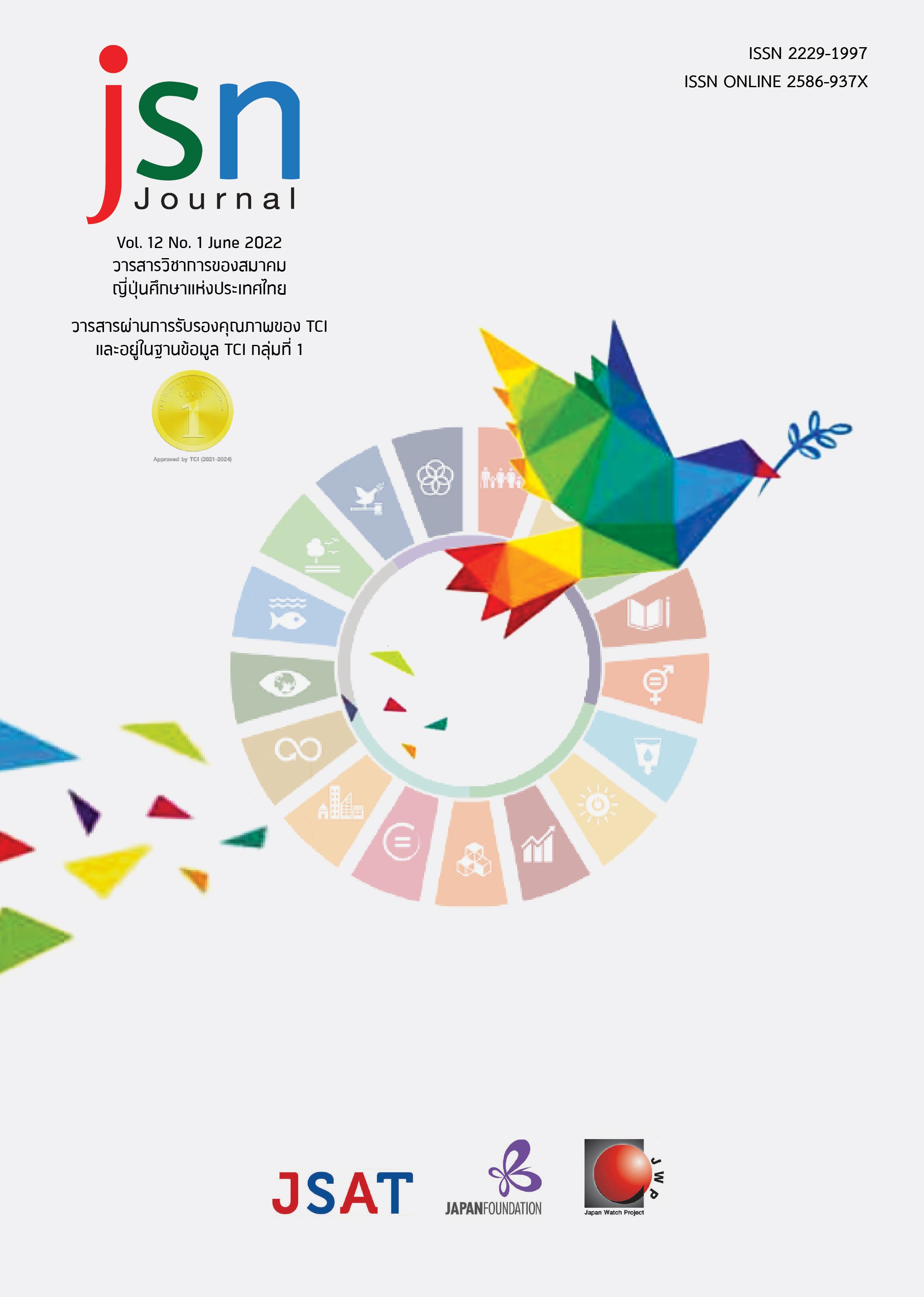The Use of Binary Opposition in Novel Kentoushi
Main Article Content
Abstract
Japanese literature that introduces the concept of dystopia has become popular and has increasingly been mentioned nowadays. The novel Kentoushi, written by Tawada Yoko, is a dystopian novel that portrays Tokyo as degraded, complicated and impoverished city due to the threat of the atomic bomb. This dystopian vision of the future of Tokyo is created through the main elements of the story such as the characters and settings. This research aims to explore how Tawada Yoko uses binary opposition to present the concept of dystopia. and to examine how the concept of dystopia illustrates the problems that exist in contemporary Japanese society. From the study, it was found that Tawada Yoko uses binary opposition, such as old people - children and young people, women - men, central city - marginal city, developing country - developed country, to present Japan's dystopian future with a shift of power and a shift from traditional relationships between the pairs. This concept of dystopia illustrates the current social issues, namely the issue of aging society and the dangers of scientific advancement.
Article Details

This work is licensed under a Creative Commons Attribution-NonCommercial-NoDerivatives 4.0 International License.
ข้อความและข้อคิดเห็นต่างๆ ในบทความเป็นของผู้เขียนบทความนั้นๆ ไม่ใช่ความเห็นของกองบรรณาธิการหรือของวารสาร jsn Journal
References
นรีนุช ดำรงชัย. นรีนุช ดำรงชัย. (2562). ญี่ปุ่นยุคร่วมสมัย: การเปลี่ยนแปลงทางสังคม การเมือง เศรษฐกิจและวัฒนธรรม. สำนักพิมพ์สถาบันบัณฑิตพัฒนบริหารศาสตร์.
ปราง ศรีอรุณและทอแสง เชาว์ชุติ. (2561). มหานครดิสโทเปียในอาชญนิยายญี่ปุ่นเรื่อง “ราตรีสีเลือด. วารสารภาษาและวัฒนธรรม, ปีที่ 37(1). สถาบันวิจัยภาษาและวัฒนธรรมเอเชีย มหาวิทยาลัยมหิดล.
อาทิตย์ บริบูรณ์ธรรม. (2523). ญี่ปุ่นมืด. สำนักพิมพ์ดวงตะวัน.
อิราวดี ไตลังคะ. (2542). แนวทางวรรณกรรมวิจารณ์ตะวันตกเพื่อแง่มุมการวิจารณ์ที่หลากหลาย. วารสารมนุษยศาสตร์, เล่มที่ 7, 77-88.มหาวิทยาลัยเกษตรศาสตร์.
ภัยพิบัติฟุกุชิมะ: เกิดอะไรขึ้นกับโรงไฟฟ้านิวเคลียร์ (11 มีนาคม 2021). https://www.bbc.com/thai/international56344107
Sutherland, J. (แปลโดย สุรเดช โชติอุดมพันธ์). (2561). วรรณกรรม ประวัติศาสตร์เรื่องเล่าแห่งจินตนาการ. Bookscape.
Atwood, M. (2021). What is Dystopian Fiction? Learn About the 5 Characteristics of Dystopian Fiction
Beauchamp, G. (1986). Technology in the Dystopian Novel. Modern Fiction Studies, Vol. 32(1), Special Issue: Science and Fantasy Fiction, 53-63.
Horan, T. (2019). Desire and Empathy in Twentieth-Century Dystopian Fiction. Palgrave Macmillan.
Hurlock, E. B. (1978 ). Child Psychology. Auckland. McGraw-Hill.
Moichi, Yoriko. (1999). Japanese Utopian Literature from the 1870s to the Present and the Influence of Western Utopianism. Utopian Studies, Vol.10 (2). Penn State University Press, 89–97.
Muramatsu, Naoko / Akiyama,Hiroko. (2011). “Japan: Super-Aging Society Preparing for the Future”, The Gerontological Society of America. Vol. 51, No. 4. Oxford University Press. 425–432. https://doi.org/10.1093/geront/gnr067
Napier, R. A. (2006). Active Submission: The Subversion of Gendered Binary Oppositions in Three Post-War Novels Authored by International Women. Master's Thesis, University of Tennessee. https://trace.tennessee.edu/utk_gradthes/1750
Prakash Gyan (edited). (2010). Noir Urbanisms-Dystopic Images of the Modern City. Princeton University Press.
Tamas, M. (2019). Tales of an Improbable Reality and Its Consequences. Yoko Tawada’s The Emissary. Acta Iassyensia Comparationis, Issue no. 24, 117-127.
Tsutsui, William M. (2010). “Oh No, There Goes Tokyo-Recreational Apocalypse and the City in Postwar Japanese Popular Culture”, Noir Urbanisms-Dystopic Images of the Modern City. Princeton University Press. 104-126.
Cabinet Office. (2021). https://www5.cao.go.jp/keizai-shimon/kaigi/special/future/sentaku/s2_3.html
คิมุระ ซะเอะโกะ 木村朗子(2019).「放射能災の想像力:多和田葉子「献灯使」のかたること」『2018年度フェリス女学院大学学内共同研究:ポピュリズムとアート』103-108.
โคโนะซุ ยุกิโกะ 鴻巣友李子(2014).「恐怖と笑いの『反・反ユートピア』小説」『毎日新聞』(11月9日付).
ทะวะดะ โยโกะ 多和田葉子(2017).『献灯使』. 講談社
โทะดะ คะสุยะซุ 戸田一廉(2019).「多和田葉子の『献灯使』-その主題と日本社会の風潮-」『台彎日本語文學報:46期 ,
-68.https://doi.org/10.6205/jpllat.201912(46).0003
มิยะจิมะ ฌุนอิจิ 宮嶋俊一(2013).「環境問題として水俣病事件と福島放射能汚染問題を考えるための予備的考察」『国際経営
論集』No.46,69-80.
โอะตะนิ เอะอิโกะ และ มะท์ซุกิ มิท์ซุโกะ 大谷英子・松木光子.(1995).「老人イメージと形成要因に関する調査研究: (1)大学 生の老人イメージと生活経験の関連」『日本看護研究学会雑誌18(4)』, 25-38.
ฮิบิ โยะฌิทะกะ日比嘉高 (2020).「環境と身体をめぐるポスト・ヒューマンな想像力─ 環境批評としての多和田葉子の震災後
文学 ─」The Journal of Korea Association of Japanology, Vol. 125, 1-19. https://doi.org/10.15532/kaja.2020.11.125.1


